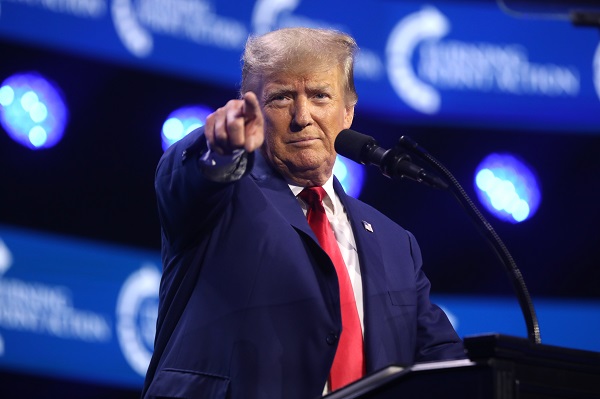Economy
Trump Could Bring Back “America First”. What Could Happen to Canada’s Natural Resource Exports?

From EnergyNow.ca
A second Trump presidency likely means more tariffs, and Canada’s energy and forestry sectors will feel the impact.
As the passing of former Prime Minister Brian Mulroney was reported, we thought back to his ratification of the North American Free Trade Agreement (NAFTA) with the United States and Mexico.
The question now is: If Donald Trump becomes the next President of the U.S., what happens to the U.S.-Mexico-Canada Agreement (USMCA) of 2020? The USMCA came after Trump threatened to pull out of NAFTA in 2018.
On Monday, the Supreme Court of the United States recently overturned a ruling from the Colorado Supreme Court that barred Trump from appearing on the ballot during the 2024 presidential election, clearing a major obstacle in his goal of once again winning the presidency in November.
If Trump does win again in November, stand by for round two of the “America First” campaign of his first term.
“After decades of the status quo, President Trump has made it clear that Americans will no longer take back seat to the rest of the world,” said Ken Farnaso, who was a deputy national press secretary during Trump’s ultimately unsuccessful 2020 re-election campaign.
So prepare, for starters, for a 10 percent tariff on imports into the U.S. — and Canada is the second largest source of those imports.
Trump’s promised tariffs would hammer Canadian exports to the U.S. In 2021 (the latest figures we see), those exports were worth $355 billion, including oil ($78.8 billion), automobiles ($26.4 billion), and natural gas ($13.4 billion).
What would Trump do about increased exports of Canadian oil to the U.S. through the Trans Mountain Expansion Project? What about our natural-gas exports, which have helped the U.S. become the world’s biggest exporter of liquefied natural gas (LNG)?
And a Trump presidency would undoubtedly mean more trouble for Canada’s forestry sector. It has long been fighting “entirely unwarranted,” U.S. tariffs on our softwood lumber — and now has been told that America will soon boost the border-crossing charges to 13.86 percent, up from 8.05 percent.
(Under the U.S. Tariff Act, the Department of Commerce determines whether goods are being sold at less than fair value or if they’re benefiting from subsidies provided by foreign governments. U.S. producers insist that provincial stumpage fees are so low as to amount to an unfair subsidy.)
And on foreign affairs, note Trump’s tough promise for China: tariffs of 60 percent or higher on imported Chinese goods. And, he has added, “Maybe it’s going to be more than that.”
This comes after the trade war he triggered during his first term as president when he imposed $250 billion in China tariffs. That disrupted the global economy, hammered consumers, and hit stock markets.
U.S. stock-market watchers have shuddered at this new promise. Nikki Haley, who suspended her campaign for the Republican nomination on Wednesday morning, has said: “What Donald Trump’s about to do, is he’s going to raise every (American) household’s expenses by $2,600 a year.”
Trump has said nothing about current U.S.-Canada relations, but has in the past declared:
- “We lose with Canada — big-league. Tremendous, tremendous trade deficits with Canada.”
- “Canada has been very difficult to deal with. . . . They’re very spoiled.”
-
“Canada, what they’ve done to our dairy farm workers, it’s a disgrace.”
Roland Paris, a Canada-based associate fellow of the U.S. and the Americas Program writes:
“ Canada is not the only country bracing for Donald Trump’s possible return to the White House – but few have more at stake.”
“Three-quarters of Canada’s goods exports, accounting for more than one-quarter of the country’s gross domestic product, go to the U.S. Given Trump’s impulsiveness and deeply protectionist instincts, Canada’s business and political leaders are understandably nervous.”
Prime Minister Justin Trudeau told business leaders in Montreal: “It wasn’t easy the first time, and if there is a second time, it won’t be easy either.”
Indeed. If the second time begins with Trump being elected on November 5, and sworn in on January 20, 2025, it could be a nasty case of “Oh, Canada.”
Bjorn Lomborg
Net zero’s cost-benefit ratio is CRAZY high

From the Fraser Institute
The best academic estimates show that over the century, policies to achieve net zero would cost every person on Earth the equivalent of more than CAD $4,000 every year. Of course, most people in poor countries cannot afford anywhere near this. If the cost falls solely on the rich world, the price-tag adds up to almost $30,000 (CAD) per person, per year, over the century.
Canada has made a legal commitment to achieve “net zero” carbon emissions by 2050. Back in 2015, then-Prime Minister Trudeau promised that climate action will “create jobs and economic growth” and the federal government insists it will create a “strong economy.” The truth is that the net zero policy generates vast costs and very little benefit—and Canada would be better off changing direction.
Achieving net zero carbon emissions is far more daunting than politicians have ever admitted. Canada is nowhere near on track. Annual Canadian CO₂ emissions have increased 20 per cent since 1990. In the time that Trudeau was prime minister, fossil fuel energy supply actually increased over 11 per cent. Similarly, the share of fossil fuels in Canada’s total energy supply (not just electricity) increased from 75 per cent in 2015 to 77 per cent in 2023.
Over the same period, the switch from coal to gas, and a tiny 0.4 percentage point increase in the energy from solar and wind, has reduced annual CO₂ emissions by less than three per cent. On that trend, getting to zero won’t take 25 years as the Liberal government promised, but more than 160 years. One study shows that the government’s current plan which won’t even reach net-zero will cost Canada a quarter of a million jobs, seven per cent lower GDP and wages on average $8,000 lower.
Globally, achieving net-zero will be even harder. Remember, Canada makes up about 1.5 per cent of global CO₂ emissions, and while Canada is already rich with plenty of energy, the world’s poor want much more energy.
In order to achieve global net-zero by 2050, by 2030 we would already need to achieve the equivalent of removing the combined emissions of China and the United States — every year. This is in the realm of science fiction.
The painful Covid lockdowns of 2020 only reduced global emissions by about six per cent. To achieve net zero, the UN points out that we would need to have doubled those reductions in 2021, tripled them in 2022, quadrupled them in 2023, and so on. This year they would need to be sextupled, and by 2030 increased 11-fold. So far, the world hasn’t even managed to start reducing global carbon emissions, which last year hit a new record.
Data from both the International Energy Agency and the US Energy Information Administration give added cause for skepticism. Both organizations foresee the world getting more energy from renewables: an increase from today’s 16 per cent to between one-quarter to one-third of all primary energy by 2050. But that is far from a transition. On an optimistically linear trend, this means we’re a century or two away from achieving 100 percent renewables.
Politicians like to blithely suggest the shift away from fossil fuels isn’t unprecedented, because in the past we transitioned from wood to coal, from coal to oil, and from oil to gas. The truth is, humanity hasn’t made a real energy transition even once. Coal didn’t replace wood but mostly added to global energy, just like oil and gas have added further additional energy. As in the past, solar and wind are now mostly adding to our global energy output, rather than replacing fossil fuels.
Indeed, it’s worth remembering that even after two centuries, humanity’s transition away from wood is not over. More than two billion mostly poor people still depend on wood for cooking and heating, and it still provides about 5 per cent of global energy.
Like Canada, the world remains fossil fuel-based, as it delivers more than four-fifths of energy. Over the last half century, our dependence has declined only slightly from 87 per cent to 82 per cent, but in absolute terms we have increased our fossil fuel use by more than 150 per cent. On the trajectory since 1971, we will reach zero fossil fuel use some nine centuries from now, and even the fastest period of recent decline from 2014 would see us taking over three centuries.
Global warming will create more problems than benefits, so achieving net-zero would see real benefits. Over the century, the average person would experience benefits worth $700 (CAD) each year.
But net zero policies will be much more expensive. The best academic estimates show that over the century, policies to achieve net zero would cost every person on Earth the equivalent of more than CAD $4,000 every year. Of course, most people in poor countries cannot afford anywhere near this. If the cost falls solely on the rich world, the price-tag adds up to almost $30,000 (CAD) per person, per year, over the century.
Every year over the 21st century, costs would vastly outweigh benefits, and global costs would exceed benefits by over CAD 32 trillion each year.
We would see much higher transport costs, higher electricity costs, higher heating and cooling costs and — as businesses would also have to pay for all this — drastic increases in the price of food and all other necessities. Just one example: net-zero targets would likely increase gas costs some two-to-four times even by 2030, costing consumers up to $US52.6 trillion. All that makes it a policy that just doesn’t make sense—for Canada and for the world.
2025 Federal Election
POLL: Canadians want spending cuts

 By Gage Haubrich
By Gage Haubrich
The Canadian Taxpayers Federation released Leger polling showing Canadians want the federal government to cut spending and shrink the size and cost of the bureaucracy.
“The poll shows most Canadians want the federal government to cut spending,” said Gage Haubrich, CTF Prairie Director. “Canadians know they pay too much tax because the government wastes too much money.”
Between 2019 and 2024, federal government spending increased 26 per cent even after accounting for inflation. Leger asked Canadians what they think should happen to federal government spending in the next five years. Results of the poll show:
- 43 per cent say reduce spending
- 20 per cent say increase spending
- 16 per cent say maintain spending
- 20 per cent don’t know
The federal government added 108,000 bureaucrats and increased the cost of the bureaucracy 73 per cent since 2016. Leger asked Canadians what they think should happen to the size and cost of the federal bureaucracy. Results of the poll show:
- 53 per cent say reduce
- 24 per cent say maintain
- 4 per cent say increase
- 19 per cent don’t know
Liberal Leader Mark Carney promised to “balance the operating budget in three years.” Leger asked Canadians if they believed Carney’s promise to balance the budget. Results of the poll show:
- 58 per cent are skeptical
- 32 per cent are confident
- 10 per cent don’t know
“Any politician that wants to fix the budget and cut taxes will need to shrink the size and cost of Ottawa’s bloated bureaucracy,” Haubrich said. “The polls show Canadians want to put the federal government on a diet and they won’t trust promises about balancing the budget unless politicians present credible plans.”
-

 2025 Federal Election18 hours ago
2025 Federal Election18 hours agoOttawa Confirms China interfering with 2025 federal election: Beijing Seeks to Block Joe Tay’s Election
-

 Energy1 day ago
Energy1 day agoIndigenous-led Projects Hold Key To Canada’s Energy Future
-

 Energy1 day ago
Energy1 day agoMany Canadians—and many Albertans—live in energy poverty
-

 Business1 day ago
Business1 day agoCanada Urgently Needs A Watchdog For Government Waste
-

 2025 Federal Election17 hours ago
2025 Federal Election17 hours agoHow Canada’s Mainstream Media Lost the Public Trust
-

 2025 Federal Election7 hours ago
2025 Federal Election7 hours agoBREAKING: THE FEDERAL BRIEF THAT SHOULD SINK CARNEY
-

 International1 day ago
International1 day agoPope Francis has died aged 88
-

 2025 Federal Election17 hours ago
2025 Federal Election17 hours agoReal Homes vs. Modular Shoeboxes: The Housing Battle Between Poilievre and Carney





